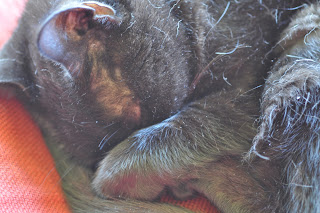Like most cities, Nijmegen has a Very Excellent Library. Besides having all the books you can possibly read, there is a CD collection that would put most of the record stores here to shame, free Internet access for card holders, music books and a few soundproof rooms so that you can try out the piece on a piano, DVDs, and a little cafe. Alas, the coffee isn't free, but the fact that you're allowed to eat and drink in a library while reading books is a new one for me--most libraries in the States are "No food or drinks allowed" zones.
Much to my chagrin, though, I'd never applied for a library card there. The reasons were several--for the first three years I lived here, I didn't work in Nijmegen, and consequently spent more time out of the city than in it. The next year I was unemployed, so it's only now that I've reached some kind of routine with the Little It preparations and the business that I've been able to find the wherewithal to ask for a library card.
Unlike libraries in the States, though, the libraries here aren't free. It costs €55 per year to get a library card that will allow you to borrow anything you want; the alternative is to get a free library card but pay €3.50 for every item you borrow. I can understand why they do this--the Philadelphia Free Library has to go through a funding fight every year--but I'm still a bit peeved that it costs as much as a train pass.
The other thing we discovered this weekend was the Gofferpark Zwembad, which, as you might have surmised from the title of the post, is a pool, or rather a system of outdoor pools. They're open in the summers, and while it's a bit pricey--€4.40 for an adult--it's easy to spend an entire day there, and judging from the sunburns we saw yesterday, a lot of people do. They have three pools, of varying depths: a kiddie pool, which is about 1 foot deep and for toddlers and the like; a pool 1.1 m deep or thereabouts, for people to just relax in; and a 2 m pool for swimming laps. There is also an enormous waterslide, but the line for that was pretty long. Most of the time it's pretty empty, but on hot days (defined in the Netherlands as anything above 25° C) everybody goes there. There's a lot of grassy areas to sunbathe on and a snackbar selling ice cream and sodas, though this being the Netherlands, there is no prohibition against bringing your own snacks.
The most incredible thing about the pool? The complete and total anarchy--and the relative orderliness of the place in spite of it. There weren't any visible lifeguards anywhere, though I'm pretty sure someone somewhere was watching, as I heard a whistle go off once or twice. But as for a guy in a high chair and sunglasses watching kids play? Nope. Also, too--the fact that all over the place were unattended bags, towels, lawnchairs, etc. They do have tiny lockers available to store cell phones and wallets, so I guess everybody knew that there wouldn't be anything worth stealing, but even so, given that you only have to leave your bicycle unattended for 30 seconds before it disappears, it was quite a revelation to see so much stuff left around, and nobody giving a damn. The last thing--and I mention this because some people might not realize this--is that there are no showers (beyond the outdoor ones for a quick rinse), and the changing area and toilets are co-ed. There are booths you can use to change in, so nobody's running around stark naked or anything.


